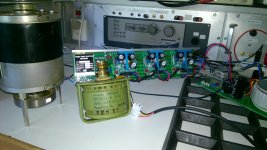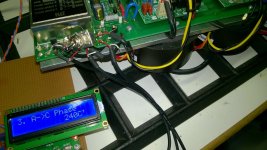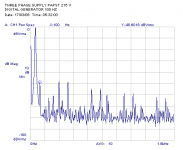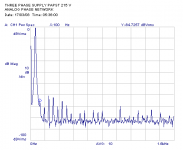Well that's embarrassing.. lol Now I know something I didn't.
It seems from my limited experience with these bushings that in some cases they expanded with use. Does it seem likely to you that this problem might have been created by owners subsequently using the wrong lubricants or is there something else going on here? (Yours obviously still works and has been owned by someone who knew to use the right lubricant)
It seems from my limited experience with these bushings that in some cases they expanded with use. Does it seem likely to you that this problem might have been created by owners subsequently using the wrong lubricants or is there something else going on here? (Yours obviously still works and has been owned by someone who knew to use the right lubricant)
I don't see any reason for embarassment here. This is just the way things are. Most of the early TD124s must have changed hands a number of times by now. The chances that the deck and the original instruction manual are still together after almost 60 years must be pretty slim. Even if a new owner wants to lay his hands on a manual in all probability he will get a later one and never know the difference. I was just lucky enough to get the original manual when I bought my TD124 in 1988. Since I don't suffer from the Real Men Don't Read Instruction Manuals Syndrome, I actually read it and noticed that the nylon bushings required a silicone lubricant rather than the usual mineral or synthetic oil. In my limited experience the wrong lubricant theory seems to offer the best explanation, but who knows, there may be other forces at work here as well.
I don't see any reason for embarassment here. This is just the way things are. Most of the early TD124s must have changed hands a number of times by now. The chances that the deck and the original instruction manual are still together after almost 60 years must be pretty slim. Even if a new owner wants to lay his hands on a manual in all probability he will get a later one and never know the difference. I was just lucky enough to get the original manual when I bought my TD124 in 1988. Since I don't suffer from the Real Men Don't Read Instruction Manuals Syndrome, I actually read it and noticed that the nylon bushings required a silicone lubricant rather than the usual mineral or synthetic oil. In my limited experience the wrong lubricant theory seems to offer the best explanation, but who knows, there may be other forces at work here as well.
Any chance of scanning and sharing your rare instruction manual?
Any chance of scanning and sharing your rare instruction manual?
He already stated previously that he found it at VE toward the bottom of the list. I checked. It's there and does mention the silicon lube requirement for the nylon bushings.
-Steve
td124 motor circuit and one more suggestion for Alfapet
I found this image in a reply to a post over at VE. The image is a sketch of the TD124 circuit (reportedly) drawn by Dr. M. Bastin. This is the first schematic I see that identifies which coils within the E50 handle which voltage. Poster goes by the moniker Hugo.
I thought to share with this group .
Which brings me up to alfapet's plea for help with regard to his slow running TD124. We should review this to see if it is a valid schematic of the motor cuicuit.
My other thought to the 5% slowness is the motor coils themselves. Next step should be an ohms check of all the coils within that e50.
I've been going like this
coil 1:
black - yellow:_ohms
black - red:_ohms
black - green: _ohms
repeat for coil 2:
Then check that the reads between coil #1 and coil #2 are within a couple of ohms of each other on each color lead.
Thanks to some consultation with kevinkr I've been able to isolate the bad coils from the usable ones on a couple of different troublesome E50s I've had over here. And now with replacement coils available from AudioSilente, it is a straight-forward process to completely renew one of these motors.
-Steve
An externally hosted image should be here but it was not working when we last tested it.
I found this image in a reply to a post over at VE. The image is a sketch of the TD124 circuit (reportedly) drawn by Dr. M. Bastin. This is the first schematic I see that identifies which coils within the E50 handle which voltage. Poster goes by the moniker Hugo.
I thought to share with this group .
Which brings me up to alfapet's plea for help with regard to his slow running TD124. We should review this to see if it is a valid schematic of the motor cuicuit.
My other thought to the 5% slowness is the motor coils themselves. Next step should be an ohms check of all the coils within that e50.
I've been going like this
coil 1:
black - yellow:_ohms
black - red:_ohms
black - green: _ohms
repeat for coil 2:
Then check that the reads between coil #1 and coil #2 are within a couple of ohms of each other on each color lead.
Thanks to some consultation with kevinkr I've been able to isolate the bad coils from the usable ones on a couple of different troublesome E50s I've had over here. And now with replacement coils available from AudioSilente, it is a straight-forward process to completely renew one of these motors.
-Steve
The Papst (not Pabst) can be installed in any TD-124 as it was intended as a universal replacement for all E50s. (I doubt it found its way into many of the cheaper tables using the E50.) I am not aware of anyone currently making a replacement motor, there's not much if any demand, and there are plenty of parts available for the E50 motor.
Note that no MKII was equipped with one of these motors from the factory as these motors were developed 10yrs after production of the 124 ceased. (They ran out of spare E50s and to their credit developed this as a replacement - almost no one would do this today.)
The Papst motor particularly 120V examples go for big money, about half of what an entire unrestored TD-124 typically sells for. Deals sometimes pop up, but are rare.
My limited experience with the Papst and a lot of anecdotal information indicates that the Papst is not an improvement performance wise (noise in particular) over the original motor unless it is run on 3 phase power, hence my 3 phase source project to allow me to use it to best advantage.
There are a number of modern Papst Aussenlaufer motors that can be adapted to the 124, access to a machine shop to fabricate the mounting hardware is required. (They show up on eBay from time to time and are shaded pole 3 phase Aussenlaufers with the correct output shaft diameter - usually flagged for use in 124s)
Note that no MKII was equipped with one of these motors from the factory as these motors were developed 10yrs after production of the 124 ceased. (They ran out of spare E50s and to their credit developed this as a replacement - almost no one would do this today.)
The Papst motor particularly 120V examples go for big money, about half of what an entire unrestored TD-124 typically sells for. Deals sometimes pop up, but are rare.
My limited experience with the Papst and a lot of anecdotal information indicates that the Papst is not an improvement performance wise (noise in particular) over the original motor unless it is run on 3 phase power, hence my 3 phase source project to allow me to use it to best advantage.
There are a number of modern Papst Aussenlaufer motors that can be adapted to the 124, access to a machine shop to fabricate the mounting hardware is required. (They show up on eBay from time to time and are shaded pole 3 phase Aussenlaufers with the correct output shaft diameter - usually flagged for use in 124s)
Hi Kevinkr,
Would you be prepared to share your three phase PSU design once it is done? I am no electronics fundi and wouldn't have a clue on where to start. I have a TD-124 with a Papst motor, plus a spare packed away in a deep dark place (which means I can't remember where)
KevinH (South Africa)
Would you be prepared to share your three phase PSU design once it is done? I am no electronics fundi and wouldn't have a clue on where to start. I have a TD-124 with a Papst motor, plus a spare packed away in a deep dark place (which means I can't remember where)
KevinH (South Africa)
Hi Kevin,
This one is a Mark Kelly design so I can't share it unfortunately.
I am working on one of my own but it might be five or six years out since it is not high priority unless I can't get the Kelly controller working.
Should you need a single phase 50/60Hz 100 -120/200 - 240V source I published the design on a thread here on the analog source forum.
This one is a Mark Kelly design so I can't share it unfortunately.
I am working on one of my own but it might be five or six years out since it is not high priority unless I can't get the Kelly controller working.
Should you need a single phase 50/60Hz 100 -120/200 - 240V source I published the design on a thread here on the analog source forum.
Three phase supply
My three phase supply for the Thorens Papstmotor is ready.The adjusting of the analog phase shifter should be done with a phasemeter .I think about to provide this complete unit with the output amplifier.And the analogue oscillator also which has the transformer and rectifiers on it for the poweramps, this oscillator needs adjustment also for low distorsion.

My three phase supply for the Thorens Papstmotor is ready.The adjusting of the analog phase shifter should be done with a phasemeter .I think about to provide this complete unit with the output amplifier.And the analogue oscillator also which has the transformer and rectifiers on it for the poweramps, this oscillator needs adjustment also for low distorsion.

How about using one of these as the signal generator?
NEW 3-Phase Sinusoidal Signal Generator Adjustable Phase 0.1?2000 Hz | eBay
I've bought one and am going to try it in combination with the output part of the circuit (in triplicate) of this:
http://www.norre.dk/TTPSU/TTPSU.html#How to use it_|outline
I'm still collecting parts at the moment, but it should be weeks rather than years before I have a working prototype.
NEW 3-Phase Sinusoidal Signal Generator Adjustable Phase 0.1?2000 Hz | eBay
I've bought one and am going to try it in combination with the output part of the circuit (in triplicate) of this:
http://www.norre.dk/TTPSU/TTPSU.html#How to use it_|outline
I'm still collecting parts at the moment, but it should be weeks rather than years before I have a working prototype.
Volken, I've been following with interest.
Ralph please let us know how well this source works, had one been available a few years ago when I got started I would have gone this route instead I think, not only much less expensive, but probably much easier to set up as well.
Ralph please let us know how well this source works, had one been available a few years ago when I got started I would have gone this route instead I think, not only much less expensive, but probably much easier to set up as well.
I will of course update, with details and pictures, as soon as I have something worthwhile to show.
My Td124 has the E50 motor which I have thoroughly refurbished, but I also have a Papst; it will be interesting to see what the relative vibration levels are, when the Papst is fed from a decent 3 phase supply.
My Td124 has the E50 motor which I have thoroughly refurbished, but I also have a Papst; it will be interesting to see what the relative vibration levels are, when the Papst is fed from a decent 3 phase supply.
How about using one of these as the signal generator?
NEW 3-Phase Sinusoidal Signal Generator Adjustable Phase 0.1?2000 Hz | eBay
I've bought one and am going to try it in combination with the output part of the circuit (in triplicate) of this:
http://www.norre.dk/TTPSU/TTPSU.html#How to use it_|outline
I'm still collecting parts at the moment, but it should be weeks rather than years before I have a working prototype.

I have tried this to and it works but the it is not so clean as a analog oscillator which is important for min.motorvibrations.


Please can you tell me whether those graphs are of the oscillator outputs or vibration of the motor?
I'm more than happy to accept that analog oscillators can provide a lower distortion output, but whether this is measurably translated to motor vibration has not, as far as I am aware, been proven.
I am not interested in a variable frequency output, simply 3 phases at 50 Hz (or 60 HZ) with an accurate phase relationship. This requirement allows the addition of notch filters to significantly reduce harmonics and ensure as clean a signal as possible gets to the power amplifiers and thence to the motor.
I'm more than happy to accept that analog oscillators can provide a lower distortion output, but whether this is measurably translated to motor vibration has not, as far as I am aware, been proven.
I am not interested in a variable frequency output, simply 3 phases at 50 Hz (or 60 HZ) with an accurate phase relationship. This requirement allows the addition of notch filters to significantly reduce harmonics and ensure as clean a signal as possible gets to the power amplifiers and thence to the motor.
I would probably just use an LPF on each of the phases, note that unless you can vary the phase independently of the others on 2 of the 3 output phases you will need to make sure that the filters are closely phase matched. (I think this 3 phase source actually gives you that ability)
I use a 6th order LPF on my single phase supply with a digital source, but have not tried that with multi-phase source, I get between 70 - 80dB of suppression at the 3rd harmonic which works well since the source is a square wave.
You might get away with a simple 3rd order Sallen Key implementation or less since it is a sine source.
I use a 6th order LPF on my single phase supply with a digital source, but have not tried that with multi-phase source, I get between 70 - 80dB of suppression at the 3rd harmonic which works well since the source is a square wave.
You might get away with a simple 3rd order Sallen Key implementation or less since it is a sine source.
Hello,
I started the restoration of a mint 124 MKII of latest S.Ns . It was used by an old audiophile friend of mine for few months .It was stored for decades years till he gifted that to me...
Everything seems like to be like new. I did not operated it as motor was quite sticky due to decades of relaxing but with the old oil..
I cleaned everything required.
I did not opened the motor but I put several drops Schopper oil according the fast procedure of that simple way.
I purchased most parts from Simone Audio Silente and I replaced the below parts:
A. the old rubber idler wheel with the Simone's aluminum one with its silicone O ring,
B. I replaced the old bearing's nylatron with new and the end cup with Simone's heavy bronze type that fits nicely and looks very well made.
C. I put to motor suspension new ''jelly'' grommets
D. Schopper oil to all points where new oil is required.
E. Chassis Mushrooms of Simone's jelly type
F. New belt from the above supplier.
Motor after the external oiling ,without belt stops after 15-17 seconds and platter after 1,5 minute.
No noise, no rumble etc.Very silent.
BUT ...the platter is running faster and the adjustment of the speed adjustment knob is set at its maximum brake. It still runs faster than 33.33..... That TT has no signs of service, adjustments or repair as ex owner was the first as he purchased it new..
Also the lever has lost it's liquid and I have to replace it.Where can i find a replacement? Or how can i put new liquid inside so to keep the originality? A small drill (maybe?) underneath the lever, so to be able to fill it and close the small hole with silicone?
Any ideas and advice that you could give me will be very much appreciated.
I started the restoration of a mint 124 MKII of latest S.Ns . It was used by an old audiophile friend of mine for few months .It was stored for decades years till he gifted that to me...
Everything seems like to be like new. I did not operated it as motor was quite sticky due to decades of relaxing but with the old oil..
I cleaned everything required.
I did not opened the motor but I put several drops Schopper oil according the fast procedure of that simple way.
I purchased most parts from Simone Audio Silente and I replaced the below parts:
A. the old rubber idler wheel with the Simone's aluminum one with its silicone O ring,
B. I replaced the old bearing's nylatron with new and the end cup with Simone's heavy bronze type that fits nicely and looks very well made.
C. I put to motor suspension new ''jelly'' grommets
D. Schopper oil to all points where new oil is required.
E. Chassis Mushrooms of Simone's jelly type
F. New belt from the above supplier.
Motor after the external oiling ,without belt stops after 15-17 seconds and platter after 1,5 minute.
No noise, no rumble etc.Very silent.
BUT ...the platter is running faster and the adjustment of the speed adjustment knob is set at its maximum brake. It still runs faster than 33.33..... That TT has no signs of service, adjustments or repair as ex owner was the first as he purchased it new..
Also the lever has lost it's liquid and I have to replace it.Where can i find a replacement? Or how can i put new liquid inside so to keep the originality? A small drill (maybe?) underneath the lever, so to be able to fill it and close the small hole with silicone?
Any ideas and advice that you could give me will be very much appreciated.
Save
Save
Save
- Home
- Source & Line
- Analogue Source
- Restoring and Improving A Thorens TD-124 MKII